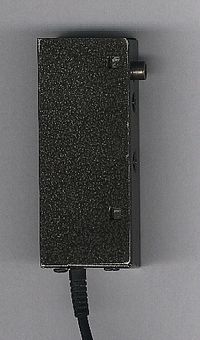RF Modulator
In the early 1980s, dedicated computer monitors were expensive devices. As well, home televisions of that era were rarely equipped with audio/video input jacks. In order to to allow people to use their own television as the VIC-20's display device, Commodore shipped all VIC-20s with an RF modulator. The modulator essentially "broadcasts" (although in closed-circuit) the VIC-20's video and audio output on frequencies corresponding to either VHF channel 3 or 4 (selected by means of a switch on the modulator itself) for NTSC for modulators and UHF channel 36 for PAL modulators (channel selection switch may not be present).
The RF modulator's electronics are contained inside a small rectangular metal box. Running from this box is a wire with a DIN type connector at the end. This connector can be plugged into the VIC-20's video output jack. Also on the metal box is a female RCA connector where one can attach the cable that runs to the GAME-TV switch-box hooked to the rear of the television. This switch-box is in turn attached to the television's antennae terminals or to its 75-Ohm Cable-TV connector and allows a user to manually toggle between broadcast television programs and the VIC-20's display.
While the RF modulator allowed the VIC-20 to be used by more people than could otherwise afford an expensive monitor, it did so at the cost of reduced picture quality. Often RF interference from external sources, lack of fine-tuning or a bad connection resulted in herring-bone interference patterns and audio/video noise (buzzing and sparkles).
Potentiometers inside the VIC-20's RF modulator allow for fine-tuning adjustments to be made to its video output frequency and audio level.





